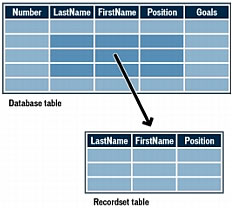Web application terminology
Web application terminology
This section defines frequently used terms relating to web applications.
An application server is software that helps a web server process web pages containing server-side scripts or tags. When such a page is requested from the server, the web server hands the page off to the application server for processing before sending the page to the browser. For more information, see How a web application works.
Common application servers include Macromedia ColdFusion, Macromedia JRun Server, the Microsoft .NET Framework, IBM WebSphere, and Apache Tomcat.
A database is a collection of data stored in tables. Each row of a table constitutes one record and each column constitutes a field in the record, as shown in the following example.

A database driver is software that acts as an interpreter between a web application and a database. Data in a database is stored in a proprietary format. A database driver lets the web application read and manipulate data that would otherwise be undecipherable.
A database management system (DBMS, or database system) is software used to create and manipulate databases. Common database systems include Microsoft Access, Oracle 9i, and MySQL.
A database query is the operation that extracts a recordset from a database. A query consists of search criteria expressed in a database language called SQL. For example, the query can specify that only certain columns or only certain records be included in the recordset.
A dynamic page is a web page customized by an application server before the page is sent to a browser. For more information, see How a web application works.
A recordset is a set of data extracted from one or more tables in a database, as in the following example:

A relational database is a database containing more than one table, with the tables sharing data. The following database is relational because two tables share the DepartmentID column.

A server technology is the technology that an application server uses to modify dynamic pages at runtime.
The Dreamweaver development environment supports the following server technologies:
- Macromedia ColdFusion
- Microsoft ASP.NET
- Microsoft Active Server Pages (ASP)
- Sun Java Server Pages (JSP)
- PHP: Hypertext Preprocessor (PHP)
You can also use the Dreamweaver coding environment to develop pages for any other server technology not listed.
A static page is a web page that is not modified by an application server before the page is sent to a browser. For more information, see Processing static web pages.
A web application is a website that contains pages with partly or entirely undetermined content. The final content of these pages is determined only when a visitor requests a page from the web server. Because the final content of the page varies from request to request based on the visitor’s actions, this kind of page is called a dynamic page.
A web server is software that sends out web pages in response to requests from web browsers. A page request is generated when a visitor clicks a link on a web page in the browser, selects a bookmark in the browser, or enters a URL in the browser’s address text box.
Popular web servers include Microsoft Internet Information Server, Microsoft Personal Web Server, Apache HTTP Server, Netscape Enterprise Server, and Sun ONE Web Server.
 |  |





